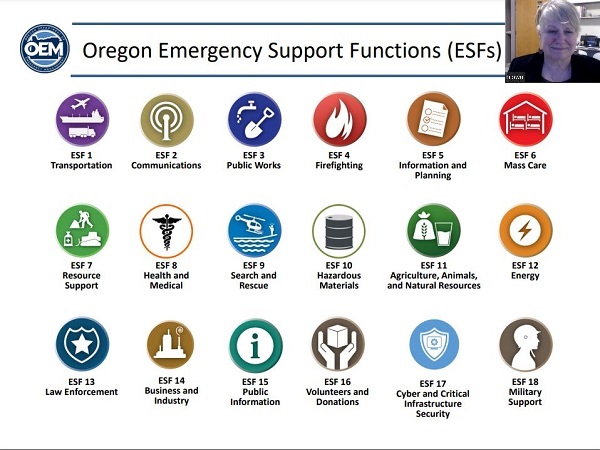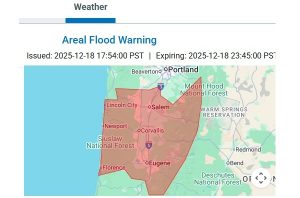Lane County’s Tiffany Brown previews ice storm lessons learned
12 min read
At the monthly meeting of the Eugene Neighborhoods Preparedness Network: Lane County’s new emergency manager. She gave a sneak preview of the county’s coming report on its ice storm response. On March 21:
Tiffany Brown (Lane County emergency manager): My first day was Monday, Feb. 5, and they had scheduled the first ‘hot wash’ on that afternoon for me to facilitate.
‘Hot wash’ is a military term that refers to a quick rinse of military equipment after a battle to ensure that they get in and get that done, quick and dirty, before they can do the longer term. And that’s what a hot wash is: To jump in after an event while all the same people are in the room, and it’s fresh in their minds, to have a conversation about where the gaps were. We very carefully frame it in terms of: Where did you see gaps and areas for improvement? And where did you see successes?
And we frame most of the conversations that way and then hope to roll everything up and identify top strengths and weaknesses and areas of improvement and actual action items like, ‘Here’s what we’re going to do to improve that thing that happened the last time.’
[00:01:12] And actually, I can’t think of a better way to start the job. I got to show up and facilitate a hot wash and meet 30 people right off the bat. And that first day was just county staff, but it really gave us sort of a blueprint of what I was going to hear for the next six weeks, you know, more in the weeds, and gave me an idea of where I needed to dig more.
[00:01:33] John Q: Emergency managers define 18 different ESFs—emergency support functions. ESFs are the organizational structures that restore key services needed for a functioning society, such as food, water, shelter, public safety, energy.
[00:01:48] Tiffany Brown (Lane County emergency manager): Yesterday, we concluded the fifth of what will be a series of seven hot washes. We did the general one with the county. We did ESF 2 for Communications to talk about alert and warning. We had one earlier this week for ESF 8 Health and Medical, and ESF 6 was just yesterday for Mass Care and Sheltering.
[00:02:09] And so, I teased out the ESF because we had some sensitivities and some issues and some problems that I thought really deserved acute attention and the specific partners at the table. Next week will be the final hot washes and those are general and I’ve invited our more tactical partners, Fire and Public Works.
[00:02:33] My first week I had a fire chief kind of take me on at a meeting for conducting a hot wash with just county staff. And I explained to him that we were viewing it in concentric circles; honestly, that the county probably did it is out of consideration for me, to some extent.
[00:02:50] But I think it’s a good way to do it. And today I was at the Fire Defense Board meeting and I said this to them today: My expectation for my tactical operational partners—Fire and Police and those folks out in the field doing all the good work—is that by the time they get to my hot wash, which is focused primarily on coordination and communication with the county Emergency Operations Center and how we can better support people—that they’ve already done their own work about their own response and their own tactical response.
[00:03:21] And so by the time we come to the table as a group, it’s: How do we work better together?
[00:03:27] John Q: Egan Warming Center volunteers suggested the cities—and the county—were slow to get started during the emergency.
[00:03:36] Dr. Frances Munkenbeck (Egan volunteer): One thing that stood out is that the emergency wasn’t declared till Tuesday. And I just got done taking a sheltering course. And they say that emergencies need to start local, and then ramp up to state and federal. Because the state and federal take a while to, ramp up. They take days to weeks. And so it was pretty clear that the local wasn’t moving along.
[00:04:01] Tiffany Brown (Lane County emergency manager): Yeah, we had a hot wash yesterday to talk about mass care with Egan partners and Public Health and whatnot. And I think we came up with a good plan for moving forward.
[00:04:11] It absolutely was a challenge for Egan and the volunteers to have the housed population on top of the usual guests. And in fact, it’s just—it’s not a best practice, because of the specific needs for the unhoused.
[00:04:30] Another type of shelter that popped up is a ‘Decompression Shelter.’ It’s for people being discharged from the hospital, that need some sort of minor, however, follow-up care, or they didn’t have a place to go.
[00:04:42] And then a ‘Comfort Shelter,’ right up on the McKenzie (River) they had people showing up just to charge their phones, take a shower, and plug their computer in.
[00:04:50] And so I think this incident really invited us to start unpacking of what caring for community members mean across different variables, the different types of shelters and services, and what we’re talking about when we talk about providing shelter.
[00:05:09] I want to be clear that there wasn’t a big identified need for external shelters. There was the decompression issue and there were some folks that were housed. And I want to be really clear about this too: I think the Egan Center, I think what challenged them was having that unanticipated population and folks with medical needs and they were just overwhelmed by that.
[00:05:33] John Q: She said many of the hot wash discussions have identified different types of shelters.
[00:05:41] Tiffany Brown (Lane County emergency manager): In all of these conversations we’ve had about sheltering in the last six weeks, and as the types of shelters got more complicated and the number of people and the people involved and all the things, I had a moment of: Who are we talking about when we talk about sheltering people?
[00:05:59] And I proposed to the group yesterday that we create a master document: a mass care assessment of our county, right? And I felt like I needed to do it in Clatsop County, and we created a document that was just an assessment. It was a data collection exercise. It sliced the county up by cities and then by fire district and then it interviewed everybody and said: How many people do you have? Who are they?
[00:06:26] On one side: What resources do you have? What needs do you have? Where are you separated from one another? What do you wake up thinking about in the middle of the night when you think about Cascadia? And then just put that in a plan.
[00:06:38] And it ended up being a tool that helped us have conversations, finally, and they could say: Here’s where we are, here’s who we are, here’s what we need. So anyway, long answer, but I think we’re going to make some progress.
[00:06:55] Carlos Barrera (Friendly Area Neighborhood): I’ve been on the CERT (Community Emergency Response Team) steering committee for several years now, and I’m hoping that CERTs can be in charge of setting up emergency shelters. I thought that we would have equipment caches in key locations outside the inundation zones where there are large open areas where people are naturally going to go to anyway, if there’s a big earthquake, and that those caches would include materials for building shelters.
[00:07:18] Shelters are easy to build, you can build one over a fence, you can build one over a play structure or a playground. There’s all kinds of ways to build shelters if you just have some materials.
[00:07:28] And I also think we may need to set up food dispensing systems in those same locations.
[00:07:33] And I think that in the event of a big subduction zone earthquake that all the food stores, grocery stores and other warehouses should be immediately closed and essentially commandeered by the city, so that those foods can be utilized to feed people who need it and who don’t have access to food otherwise.
[00:07:52] John Q: Tiffany was asked to share other feedback from the county hot wash discussions.
[00:08:00] Tiffany Brown (Lane County emergency manager): Something I heard (Dr.) Frances (Munkenbeck) echo, that ‘We could have leaned into it.’ We, the county, everyone, that we could have activated more quickly. We heard that from our partners as well.
[00:08:12] That’s an interesting insight. There were mixed messages about what we were expecting. But what we learned from that event is that we don’t have a radar system pointed toward our area. And so it is why we got misinformation about the forecast. And so that’s a big thing. That’s like a big high-level thing, like even above my pay grade—conversations going on with the National Weather Service and whatnot.
[00:08:37] The radar on which we rely sits on Mount Ashland and points toward the ground far south of us. That was one of them, was ‘Leaning into it and activating sooner.’
[00:08:49] Another one was just a general, also related to reluctance. And it was, ‘Well, should we? Is it going to be an emergency?’ And the general consensus, I think, from a lot of the community leaders that we’re hearing is: We need thresholds so that we’re not doing this guesswork.
[00:09:07] So for my part, my primary responsibility is to maintain operational readiness and activate and operate the county Emergency Operations Center. And so that was a real easy one for me moving forward. If anybody else activates, I’m activating. I know that those utility companies probably were activating a day or two in advance of anything bad showing up, and that’s enough reason for the county to activate, even if we only have a couple people sitting here in monitoring status, just keeping an eye on what’s going on.
[00:09:41] John Q: Randy Prince noted that the Neighborhood Leaders Council did not give the alert system very high marks during the ice storm.
[00:09:47] Randy Prince (Eugene Neighborhood Preparedness Network): The lowest score was actually the alert system. Maybe people weren’t on it. Maybe it worked well, but it doesn’t have that capacity. We don’t quite know, but that is something that our guest tonight does know something about.
[00:10:01] Tiffany Brown (Lane County emergency manager): Okay, let’s talk about the alert system. Last year in June, Lane County adopted a new alerting system, their operating software. Until June of last year, they had been using a system called AlertSense, and the state adopted a contract and most of the counties went in on it.
[00:10:23] And Lane County was one of the last to join, but last June they did. And now the operating software in your alerting system in Lane County is called Everbridge. I helped get that set up actually last June. (Former Lane County Emergency Manager) Patence (Winningham) and I were working together and I’ve used the system. I’ve used Everbridge for 10 years.
[00:10:43] And so we downloaded the people out of AlertSense and we uploaded them into Everbridge. And that was about the third week of June.
[00:10:52] It looks to me like very few, if any alerts have gone out since last June, maybe a couple during the wildfires in the fall, and I only found one that went out during the ice storm and it was with respect to a resource center opening in Springfield.
[00:11:09] They moved to a new system and the selling point was, you know, ‘It’s more robust and it can do a lot more.’ And that’s true, it can. It’s probably the top system in the world. But does anybody remember going from their flip phone to their iPhone or their Android? It’s a little like that. There’s a lot there.
[00:11:29] So when we got the new system, the timing was such that the system got up and running, and then, in a very short time, Patence had moved on to a new job and you had your fires in the fall.
[00:11:41] And so if I was overseeing a system that I didn’t have a huge comfort level with, in terms of expanding it, I would tighten it down to that very specific emergency use. And that’s what they did. And so it hasn’t been used much.
[00:11:57] The feedback I’ve been hearing from the ice storm was, ‘Where was the alert system?’ And my takeaway is that citizens have become accustomed to really getting regular alerts during emergencies, based on what’s happened during the wildfire incidents, and were expecting that same thing to happen during the ice storm. But it didn’t, and they didn’t hear much, and so that’s a gap.
[00:12:25] So we’re really diving into this. I’ve used the (Everbridge) system for 10 years and I’m excited to get in and do some work and help raise the comfort level among the users and I think you’re going to see some broader use where—not an overuse situation—but where people can register for certain subscriptions and maybe get community alerts.
[00:12:49] And so we want to be smart and judicious, yet use the system often enough so people know what it is and subscribe. I’m thinking that we’ll try to start an annual county test to get folks, ‘Yes, I got the alert, I’m still registered,’ to encourage use and just to help people understand what that looks like and to help us understand what it looks like when we ring the whole county or do something along those lines.
[00:13:16] John Q: Some final thoughts from Carlos Barrera.
[00:13:19] Carlos Barrera (Friendly Area Neighborhood): I agree with the point that (Dr.) Frances (Munkenbeck) was making that we should focus on creating response from the ground up, rather than from the top down. Top-down organizations tend to be slow, not very robust.
[00:13:33] I’m somewhat concerned about the alert system for dam failures. It sounds like if they’re going to depend on telephones or internet to send an alert, well, if the power is out to the region, will they be able to do so? I would rather see a system that was automatic that would detect a dam failure and send an emergency message with a system that was independent of any power sources.
[00:14:02] I think that CERT in this area is being grossly ignored. I think that in the event of a major emergency, like the Cascadia Subduction Zone earthquake, that CERT could play a really crucial role because the Fire Department and the Public Works will be so overcome with what has to be done that they will not be able to be an effective force in the short term. And as we all know, the first 72 hours of a major event like that is going to be the most critical in terms of saving lives.
[00:14:36] One suggestion I’ve made is that CERTs be organized to go out and do search and rescue for critical personnel: People with EWEB, people with the city, people with the fire department, they may need some rescuing in order to go to the job. And also we, if they’re on the job, we can be searching, can be going to their homes and to their schools to check on their families to reassure them that they don’t have to leave the job to go and see to their families, that other people are handling that.
[00:15:06] And that is a system that was in use in Oakland by the fire department during the Loma Prieta earthquake, which was like 20 years ago. And here we’re not even considering that idea here yet.
[00:15:19] Also I have this book from the Professional Journal of the Earthquake Engineering Research Institute, who did an analysis of the Loma Prieta earthquake, and one of the major things that happened was, across the board, communication breakdown.
[00:15:33] People in hospitals couldn’t communicate with ambulances, police stations couldn’t connect with their police cars. It was just across the board. Nobody could communicate with anybody. And this is something that I think we need to develop a really robust communication system in order to be able to deal with that.
[00:15:50] And I think that CERTs can be utilized also with helping to clear streets of debris. There’s bound to be tons of debris in the streets, a lot of fallen trees and they can be involved in that so that fire trucks and ambulances can get to where they need to go.
[00:16:05] I also think CERTs need fire suppression training when there’s no water in the mains, because that’s a very real possibility.
[00:16:12] My thought is that CERTs who are on their way from their homes to these CERT operation centers that have been established would, if they encountered a fire, would then report that, but would not go to the center, but would instead start organizing the neighbors to put out that fire before it gets too big and starts spreading around.
[00:16:31] John Q: ENPN (Eugene Neighborhoods Preparedness Network) welcomes Lane County’s new emergency manager, Tiffany Brown. She hit the ground running Feb. 5, conducting hot wash meetings to create the county’s after-action report, with lessons learned from the ice storm. The county hopes to share its findings with the public in April or May.



